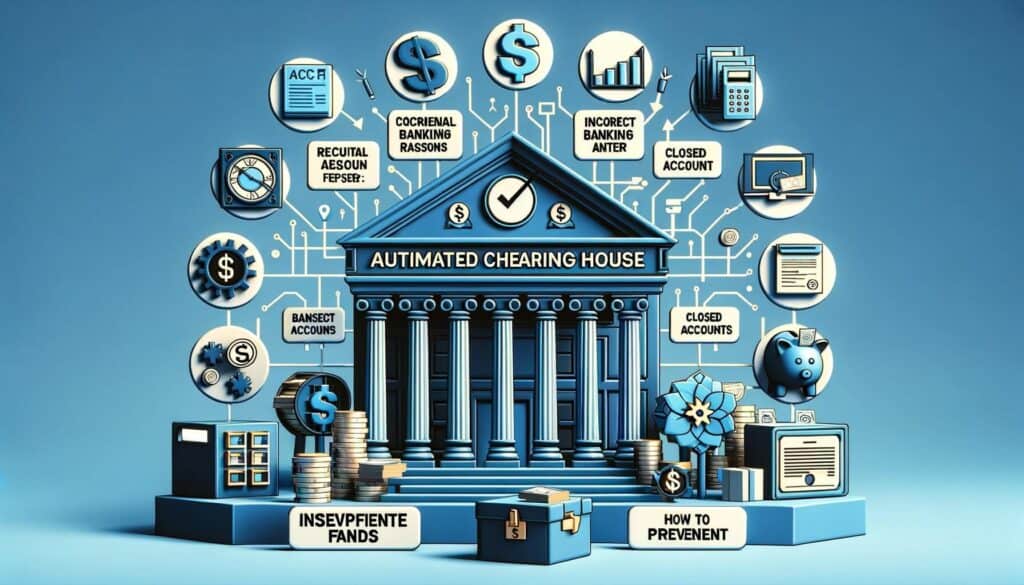
By Mollie Mills April 26, 2025
In today’s digital age, electronic payments have become the norm for businesses and individuals alike. One popular method of electronic payment is the Automated Clearing House (ACH) system, which allows for the transfer of funds between bank accounts. However, just like any other payment system, ACH transactions can sometimes encounter issues, leading to what is known as an ACH return.
In this comprehensive guide, we will delve into the world of Automated Clearing House (ACH) returns, exploring the basics, common reasons for returns, prevention strategies, the step-by-step process, ACH return codes, handling returns as a business owner or merchant, associated fees and reversal costs, best practices for resolving returns, the difference between Automated Clearing House (ACH) returns and reversals, and frequently asked questions.
Common Reasons for ACH Returns and How to Prevent Them

ACH returns can occur for various reasons, and understanding these common causes is crucial for preventing them. One common reason for returns is insufficient funds in the sender’s account. This can happen when the sender does not have enough money to cover the transaction, resulting in the return of the ACH payment. To prevent this, businesses can implement measures such as verifying account balances before initiating transactions or setting up alerts for low balances.
Another reason for Automated Clearing House (ACH) returns is invalid or closed accounts. If the account provided by the sender is no longer active or does not exist, the payment will be returned. To avoid this, it is essential to verify account information before initiating transactions and regularly update customer records.
Incorrect or missing account numbers and routing numbers can also lead to ACH returns. It is crucial to double-check the accuracy of these details to ensure successful transactions. Additionally, businesses should educate their customers on the importance of providing accurate information to avoid returns.
Fraudulent activity is another significant cause of Automated Clearing House (ACH) returns. If a transaction is flagged as potentially fraudulent, the receiving bank may return the payment. To prevent this, businesses should implement robust fraud detection and prevention measures, such as monitoring transaction patterns and using secure payment gateways.
The Process of Automated Clearing House (ACH) Returns: Step-by-Step Guide

When an ACH payment is returned, it goes through a specific process. Understanding this process is essential for businesses and individuals involved in ACH transactions. Here is a step-by-step guide to the ACH return process:
1. Return Initiation: The receiving bank initiates the return by sending a notification to the originating bank, stating the reason for the return.
2. Notification to Originator: The originating bank receives the return notification and informs the sender of the return reason.
3. Return of Funds: The originating bank debits the sender’s account for the returned amount and credits it back to the receiving bank.
4. Notification to Receiver: The receiving bank notifies the receiver of the return, providing details of the return reason and the amount returned.
5. Resolution: The receiver can take appropriate action to resolve the issue, such as correcting account information or contacting the sender for clarification.
Navigating ACH Return Codes: A Comprehensive Overview

ACH return codes are standardized codes used to indicate the reason for an ACH return. These codes provide valuable information to businesses and individuals, helping them understand why a payment was returned. Here is a comprehensive overview of some common Automated Clearing House (ACH) return codes:
R01 – Insufficient Funds: This code indicates that the sender’s account does not have enough funds to cover the transaction.
R02 – Account Closed: It signifies that the account provided by the sender is closed or no longer active.
R03 – No Account/Unable to Locate Account: This code indicates that the account number provided by the sender does not exist or cannot be located.
R04 – Invalid Account Number: It signifies that the account number provided by the sender is incorrect or does not match the account holder’s name.
R05 – Unauthorized Debit to Consumer Account: This code indicates that the transaction was not authorized by the account holder.
R10 – Customer Advises Not Authorized: It signifies that the account holder has informed the bank that the transaction was not authorized.
R29 – Corporate Customer Advises Not Authorized: This code is similar to R10 but applies to corporate accounts.
Understanding these return codes is crucial for businesses and individuals to identify and address the underlying issues causing the returns.
How to Handle ACH Returns as a Business Owner or Merchant
As a business owner or merchant, handling Automated Clearing House (ACH) returns effectively is essential for maintaining customer satisfaction and minimizing financial losses. Here are some key steps to handle ACH returns:
1. Notification and Documentation: When a payment is returned, promptly notify the customer and document the return reason and amount.
2. Review and Verify: Review the return reason and verify the accuracy of the customer’s account information. If there are any discrepancies, contact the customer for clarification.
3. Communication: Maintain open lines of communication with the customer to resolve the issue. Provide clear instructions on how to rectify the problem, such as updating account information or providing additional documentation.
4. Resubmission or Alternative Payment Method: If the return reason is due to insufficient funds or a closed account, give the customer an opportunity to rectify the issue. If necessary, offer alternative payment methods to ensure timely payment.
5. Fraud Detection and Prevention: If the return reason indicates potential fraudulent activity, investigate further and take appropriate action. Implement robust fraud detection and prevention measures to minimize the risk of future returns.
A Closer Look at ACH Return Fees and Reversal Costs
ACH returns can come with associated fees and reversal costs, which can impact businesses and individuals financially. It is crucial to understand these fees and costs to effectively manage Automated Clearing House (ACH) returns. Here is a closer look at ACH return fees and reversal costs:
ACH Return Fees: Banks and financial institutions may charge a fee for processing ACH returns. The fee amount varies depending on the institution and can range from a few dollars to more significant amounts. It is essential to review the fee structure of your bank and factor in these costs when assessing the impact of ACH returns on your business.
Reversal Costs: In addition to return fees, businesses may incur additional costs when reversing the effects of an ACH payment. For example, if a product or service was already delivered based on the initial payment, the business may need to refund the customer or provide compensation. These reversal costs can add up, especially for high-value transactions.
Best Practices for Resolving ACH Returns and Minimizing Risks
Resolving ACH returns efficiently and minimizing associated risks requires implementing best practices. Here are some key best practices for handling Automated Clearing House (ACH) returns:
1. Accurate Account Information: Ensure that you have accurate and up-to-date account information for your customers. Regularly verify account details to minimize the risk of returns due to incorrect or outdated information.
2. Clear Communication: Maintain clear and open lines of communication with your customers. Promptly notify them of any ACH returns and provide clear instructions on how to resolve the issue.
3. Fraud Detection and Prevention: Implement robust fraud detection and prevention measures to minimize the risk of fraudulent transactions. Monitor transaction patterns, use secure payment gateways, and educate your customers about potential fraud risks.
4. Payment Verification: Before initiating an ACH payment, verify the availability of funds in the sender’s account. This can help prevent returns due to insufficient funds.
5. Customer Education: Educate your customers about the importance of providing accurate account information and authorizing transactions. Clear communication and customer awareness can help minimize returns.
ACH Return vs. ACH Reversal: Key Differences Explained
While ACH returns and ACH reversals may seem similar, there are key differences between the two. Understanding these differences is crucial for effectively managing ACH transactions. Here is an explanation of the key differences between ACH returns and ACH reversals:
ACH Return: An ACH return occurs when a payment is sent back to the sender’s account due to various reasons, such as insufficient funds or invalid account information. The return is initiated by the receiving bank and involves debiting the sender’s account for the returned amount.
ACH Reversal: An ACH reversal, on the other hand, is a voluntary action initiated by the sender to reverse a payment that has already been processed. This can happen when there is a mistake or error in the transaction, or when the sender wants to cancel the payment. Unlike ACH returns, ACH reversals are initiated by the sender and involve crediting the sender’s account for the reversed amount.
Frequently Asked Questions (FAQs) about ACH Returns
Q1. What is an ACH return?
Answer: An ACH return occurs when a payment is sent back to the sender’s account due to various reasons, such as insufficient funds or invalid account information.
Q2. How can I prevent ACH returns?
Answer: To prevent ACH returns, businesses can implement measures such as verifying account balances before initiating transactions, regularly updating customer records, and educating customers about the importance of providing accurate information.
Q3. What are ACH return codes?
Answer: ACH return codes are standardized codes used to indicate the reason for an ACH return. These codes provide valuable information to businesses and individuals, helping them understand why a payment was returned.
Q4. How should I handle ACH returns as a business owner or merchant?
Answer: As a business owner or merchant, promptly notify the customer of the return, review and verify the return reason, maintain open lines of communication, and offer alternative payment methods if necessary.
Q5. What are the associated fees and costs of ACH returns?
Answer: ACH returns can come with associated fees charged by banks and financial institutions. Additionally, businesses may incur reversal costs, such as refunding customers or providing compensation.
Conclusion
ACH returns are an inevitable part of electronic payment systems, but understanding the basics, common reasons, prevention strategies, the step-by-step process, ACH return codes, handling returns as a business owner or merchant, associated fees and reversal costs, best practices for resolving returns, and the difference between ACH returns and reversals can help businesses and individuals navigate this aspect of financial transactions more effectively.
By implementing preventive measures, maintaining clear communication, and staying vigilant against fraud, businesses can minimize the occurrence of ACH returns and ensure smooth payment processes.